February 7, 2011
The Science and Beauty of Nebulae
Dr Carolin Crawford
Report by: Chris Sutcliffe
This lecture was presented by Dr Carolin Crawford, an astronomer at the Institute of Astronomy, Cambridge and a Fellow of Emmanuel College Cambridge. She is a regular contributor to BBC Radio 4’s programme “Home Planet”.
Her presentation focused on a number of amazing images of nebulae, how to read and understand them; and also to gain an understanding what lies between the stars.
Nebulae are huge clouds of interstellar dust and gas, predominantly hydrogen. Some nebulae show where new stars are being born, and some reveal what happens when stars die as thermonuclear reactions stop after millions or billions of years — stars end their lives with a spectacular detonation, called a supernova, which blows the star apart.
The space between the stars is not void, but is full of dust, atoms and molecules – the interstellar media. It is the reservoir from which stars are formed.
Carolin showed a galaxy with 100,000 million stars with spiral arms and yellow stars at the centre. The young stars in blue are in the spiral arms, and there are pink traces of gas clouds consisting mainly of hydrogen.
Rosette Nebula
This is 100 light years across and the bright blue stars are 4 million years old. By the time they radiate energy, they heat up causing a bubble around the star. This nebula is a good example of how star clouds and gas clouds live together. There are tiny particles of soot and sand 1/1,000 of the size of human hair which can black out light. Similarly, gas clouds black out light.
Milky Way
This is our galaxy of which the solar system forms part. Within it, there are dark structures consisting of molecular clouds and dust which stops the bright light and heat from the stars from penetrating the cloud.
Orion Nebula
Barnard’s Loop discovered in 1895 is an emission nebula in the constellation of Orion which is part of a giant molecular cloud which also contains the Horsehead (this is darker) and Orion nebulae. The Horsehead nebula is in fact a dark nebula; it is so opaque that it blocks any visible light from stars which lie behind it. The nebula has very low temperatures close to minus 270 degrees C which is low enough for hydrogen atoms to form molecules.
Blue light gets scattered in a dust cloud in contrast to which, red light has a long wavelength and can penetrate cloud more readily.
Orion itself is a huge area of star formation with large star clusters being formed.
Pleiades
The stars within the cluster are young and the scattered light comes from hot blue stars
Rigel
This is the brightest star in Orion and its light lights up the dust cloud in its vicinity. Infrared pictures really show up the dust since the long wavelength of red light penetrates cloud; they also show the cooler regions.
Eagle Nebula
A young star cluster formed 5½ million years ago. The Hubble Space Telescope shows this to be 10 million miles in length. One of the famous Hubble photographs known as the “Pillars of Creation” is a large area of star formation 9 light years in length. Its fingers point to star clusters and consist of interstellar hydrogen gas and dust.
Scientists used data from NASA’s Spitzer Space Telescope to measure infrared light deflecting off dark cocoons where young stars and planetary systems are blossoming.
The question is, do these cocoons go on to form other solar systems? When they were first discovered in 1995, this was the first indication of planets around other stars.
Stars like the sun last 12 billion years before their fuel supply is depleted. The chemistry creates dust ,and when the core collapses down it becomes a white dwarf.
Ring Nebula
This is found in the constellation of Lyra and is a ring of bright light-emitting material moving at high speed surrounding the central star.
Crab Nebula
This is a supernova remnant. At its centre is a neutron star which emits pulses of radiation from gamma rays and radio waves. Whilst it is not usually possible to discern changes in the night sky in 1,000 years, the Crab nebula has seen changes over 30 years.
Carolin went on to describe the process of star formation by which dense parts of molecular clouds collapse into a ball of plasma to form a star. This involves a process of gravitational pressure versus thermal pressure. The coldest and densest regions form stars but for this to happen, dust clouds are needed. If material orbits a galaxy, as soon as it starts it gets misaligned, it gets squeezed and material starts to bunch creating spiral arms.
The Heart and Soul Nebula
This nebula in the constellation of Cassiopeia is another area of old dust and large star-formation activity. In the centre are a few isolated blue stars which have not yet gone supernova. There is a second generation star cluster further out which again has not gone supernova.
The presentation was rounded off with a lively question and answer session.
Read & See More at —
Some pictures from the evening [by Grey Lipley]:
Posted under: Flamsteed, Flamsteed Lecture, Meeting Report
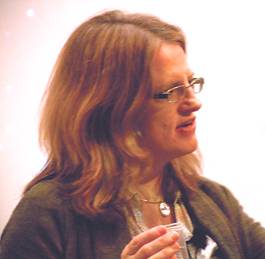
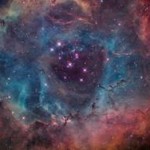
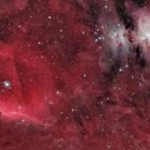
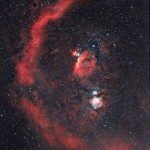
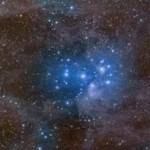
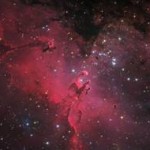
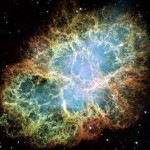
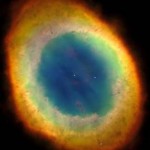
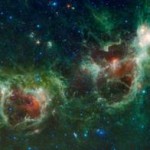












You must be logged in to post a comment.